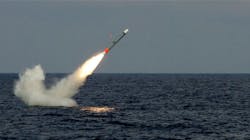Raytheon to produce sensor seeker technology for Tomahawk Block-5 missile to attack moving ships at sea
PATUXENT RIVER NAS, Md. – U.S. Navy guided missile experts are asking Raytheon Technologies Corp. to provide seeker upgrades for the BGM-109 Tomahawk missile Block 5A to enable the weapon to hit moving ships at sea.
Officials of the Naval Air Systems Command at Patuxent River Naval Air Station, Md., announced a $19.6 million order Friday to the Raytheon Missiles & Defense segment in Tucson, Ariz., to produce new sensors and subsystems that provide midcourse and terminal guidance for the Maritime Strike Tomahawk (MST).
The Maritime Strike Tomahawk, also called Tomahawk Block 5A, was introduced in 2021 with improvements to navigation and in-flight targeting that enable the long-range subsonic missile to attack enemy ships at sea. The missile fires from Navy surface warships and submerged submarines.
The maritime-strike Tomahawk Block-5A has updated seeker technology and processing capabilities to enable the missile to hit moving targets at sea.
Navy joint task force commanders increasingly face long-range anti-ship missiles that threaten their surface forces and potentially deny access to mission-critical areas of operation, so they need a near-term capability to counter hostile surface forces. Without this, the Navy could face loss of life or critical mission failure, Navy officials say.
Raytheon can integrate a new sensor suite into the Tomahawk missile that consists of a new seeker, processor, software, and a new inertial measuring unit for terminal maneuvers, as well as redesigned power budget and system cooling.
On this order Raytheon will do the work in Tucson, Ariz.; Boulder, Colo.; Dallas; North Logan, Utah; Pontiac, Mich.; and other continental U.S. locations, and should be finished by October 2024. For more information contact Raytheon Missile Systems online at www.rtx.com/our-company/our-businesses/rmd, or Naval Air Systems Command at www.navair.navy.mil.
About the Author
John Keller
Editor-in-Chief
John Keller is the Editor-in-Chief, Military & Aerospace Electronics Magazine--provides extensive coverage and analysis of enabling electronics and optoelectronic technologies in military, space and commercial aviation applications. John has been a member of the Military & Aerospace Electronics staff since 1989 and chief editor since 1995.
